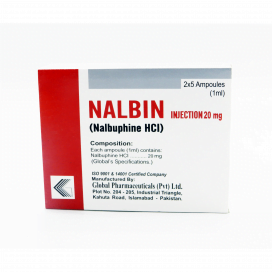Description
Introduction:
- Explanation of Nalbuphine HCL
- Importance of Nalbuphine HCL in the medical field
- Brief explanation of the article
Section 1: What is Nalbuphine HCL?
- Definition of Nalbuphine HCL
- Chemical structure
- Classification of Nalbuphine HCL
- Historical background of Nalbuphine HCL
Section 2: Uses of Nalbuphine HCL
- Pain management
- Anesthesia adjunct
- Management of opioid addiction
Section 3: Dosage and administration of Nalbuphine HCL
- Dosage forms and strengths of Nalbuphine HCL
- Dosage recommendations for different conditions
- Administration routes for Nalbuphine HCL
- Precautions to be taken while administering Nalbuphine HCL
Section 4: Side effects of Nalbuphine HCL
- Common side effects of Nalbuphine HCL
- Rare but severe side effects of Nalbuphine HCL
- Allergic reactions to Nalbuphine HCL
Section 5: Contraindications and precautions of Nalbuphine HCL
- Patients who should not take Nalbuphine HCL
- Precautions to be taken before taking Nalbuphine HCL
- Possible drug interactions with Nalbuphine HCL
Section 6: Nalbuphine HCL in clinical trials
- Recent clinical trials on Nalbuphine HCL
- Findings and implications of these trials
Section 7: Conclusion
- Summary of key points discussed in the article
- Future prospects of Nalbuphine HCL in the medical field
Introduction:
Nalbuphine HCL is a medication that is commonly used in the medical field to manage pain, as an anesthesia adjunct, and in the treatment of opioid addiction. It is a synthetic opioid that acts as a mixed agonist-antagonist, meaning that it has both agonist (activating) and antagonist (blocking) properties at opioid receptors in the body. In this article, we will explore the various aspects of Nalbuphine HCL, including its definition, uses, dosage and administration, side effects, contraindications and precautions, recent clinical trials, and future prospects.
Section 1: What is Nalbuphine HCL?
Nalbuphine HCL is a synthetic opioid that is chemically related to morphine. It has a chemical formula of C21H27NO4•HCl and a molecular weight of 393.91 g/mol. The drug acts as a mixed agonist-antagonist at the mu, delta, and kappa opioid receptors in the body, producing both pain relief and analgesia as well as some adverse effects commonly associated with opioids.
Nalbuphine HCL is classified as a Schedule II controlled substance under the Controlled Substances Act in the United States. It is available in various forms, including injectable solutions, prefilled syringes, and intravenous infusion bags. Nalbuphine HCL is also available under various brand names, including Nubain, Nalpain, and Nalbuphin.
The discovery of nalbuphine can be traced back to 1960 when it was first synthesized by Janssen Pharmaceutica, a Belgian pharmaceutical company. Since then, the drug has been used extensively in the medical field for its analgesic properties.





Reviews
There are no reviews yet.